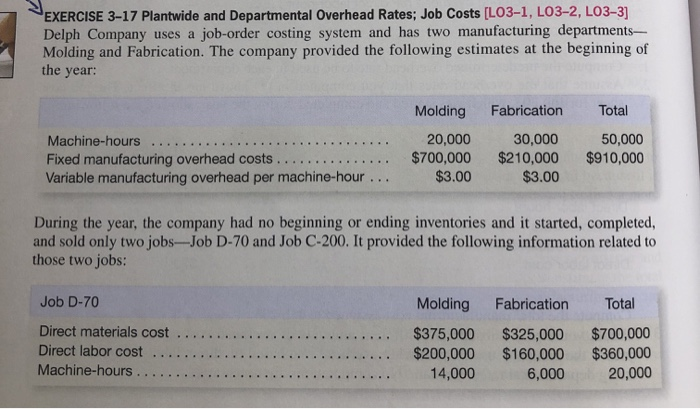EXERCISE 3-17 Plantwide and Departmental Overhead Rates; Job Costs [LO3-1, LO3-2, LO3-3] Delph Company uses a job-order costing system and has two manufacturing departments- Molding and Fabrication. The company provided the following estimates at the beginning of the year: Machine-hours ..... Fixed manufacturing overhead costs ....... Variable manufacturing overhead per machine-hour ... Molding 20,000 $700,000 $3.00 Fabrication 30,000 $210,000 $3.00 Total 50,000 $910,000 During the year, the company had no beginning or ending inventories and it started, completed, and sold only two jobs-Job D-70 and Job C-200. It provided the following information related to those two jobs: Job D-70 Direct materials cost Direct labor cost ... Machine-hours .......... Molding $375,000 $200,000 14,000 Fabrication $325,000 $160,000 6,000 Total $700,000 $360,000 20,000 Job-Order Costing Job C-200 Direct materials cost ... Direct labor cost ..... Machine-hours. Molding $300,000 $175,000 6,000 Fabrication $250,000 $225,000 24,000 $550.000 $400,000 30.000 Delph had no overapplied or underapplied manufacturing overhead during the year. Required: 1. Assume Delph uses a plantwide overhead rate based on machine-hours. a. Compute the predetermined plantwide overhead rate. b. Compute the total manufacturing costs assigned to Job D-70 and Job C-200. c. If Delph establishes bid prices that are 150% of total manufacturing costs, what bid price would it have established for Job D-70 and Job C-200? d. What is Delph's cost of goods sold for the year? Assume Delph uses departmental overhead rates based on machine-hours. a. Compute the predetermined departmental overhead rates. b. Compute the total manufacturing costs assigned to Job D-70 and Job C-200. c. If Delph establishes bid prices that are 150% of total manufacturing costs, what bid price would it have established for Job D-70 and Job C-200? d. What is Delph's cost of goods sold for the year? 3. What managerial insights are revealed by the computations that you performed in this prob- lem? (Hint: Do the cost of goods sold amounts that you computed in requirements 1 and 2 differ from one another? Do the bid prices that you computed in requirements 1 and 2 differ from one another? Why?)








